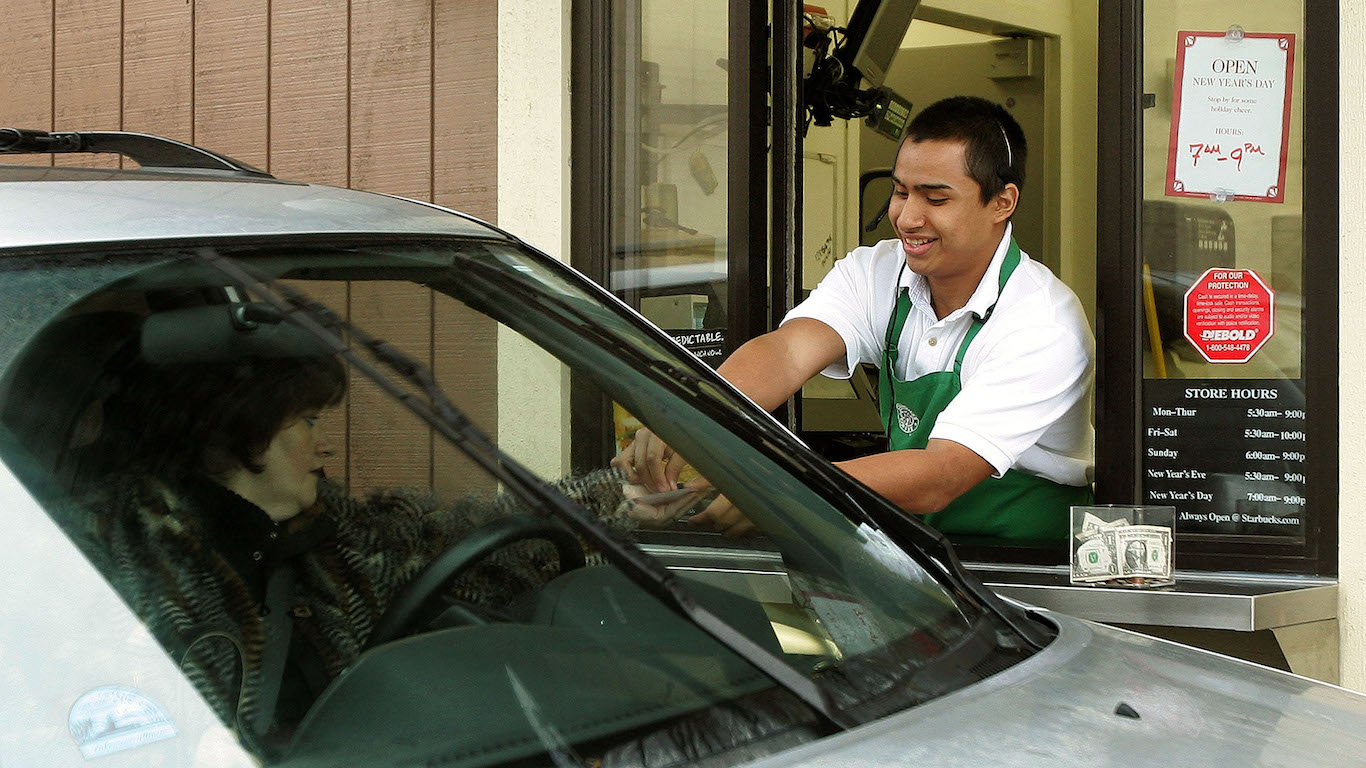
About two-thirds of the U.S. economy consists of consumer spending, making it the most important factor driving economic growth in the modern era. While drop shipping and e-commerce continue to change the way companies think about retail, major American businesses continue to expand and operate hundreds of thousands of supermarkets, coffee shops, banks, and department stores.
24/7 Wall St. reviewed foot traffic patterns provided by data service company Placed Insights, which calculated the percentage of Americans 13 and older who visited various stores in April 2019. We also reviewed U.S. sales and store count data from company financial documents.
Many of the retailers owe their popularity to the strength of their brand. Several companies this list, including McDonald’s and Starbucks also rank among the 50 most valuable brands in the world.
Though these stores range from hardware stores to coffee shops, the one thing these stores have in common is that they all sell items that are necessary and have everyday use such as health care, food, tools, appliances, and clothing. Therefore, these stores are relatively safe from major shifts in consumer trends or the United States’ shifting demographic profile compared to other businesses.
However, while they remain popular for now, several of these retailers have seen their sales decline, and the loss in business has resulted in several being among the list of retailers closing the most stores.
Click here to see the 20 most popular stores in America

20. Lowe’s
> Pct. of total US retail foot traffic: 0.33%
> Pct. of hardware & services visitors in April: 23.21%
> No. of U.S. stores: 1,723
> Annual revenue: $71.3 billion
Lowe’s hardware stores accounted for 0.33% of all U.S. retail foot traffic in April, and 23.2% of all traffic in the hardware and services category, behind rival Home Depot. The company’s annual net operating profit fell from $6.6 billion in fiscal 2017 to $4.0 billion in fiscal 2018, and the company has closed underperforming stores while shares have plummeted since April. 2019 will be a big test for new CEO Marvin Ellison to see if he can overcome these issues.
[in-text-ad]
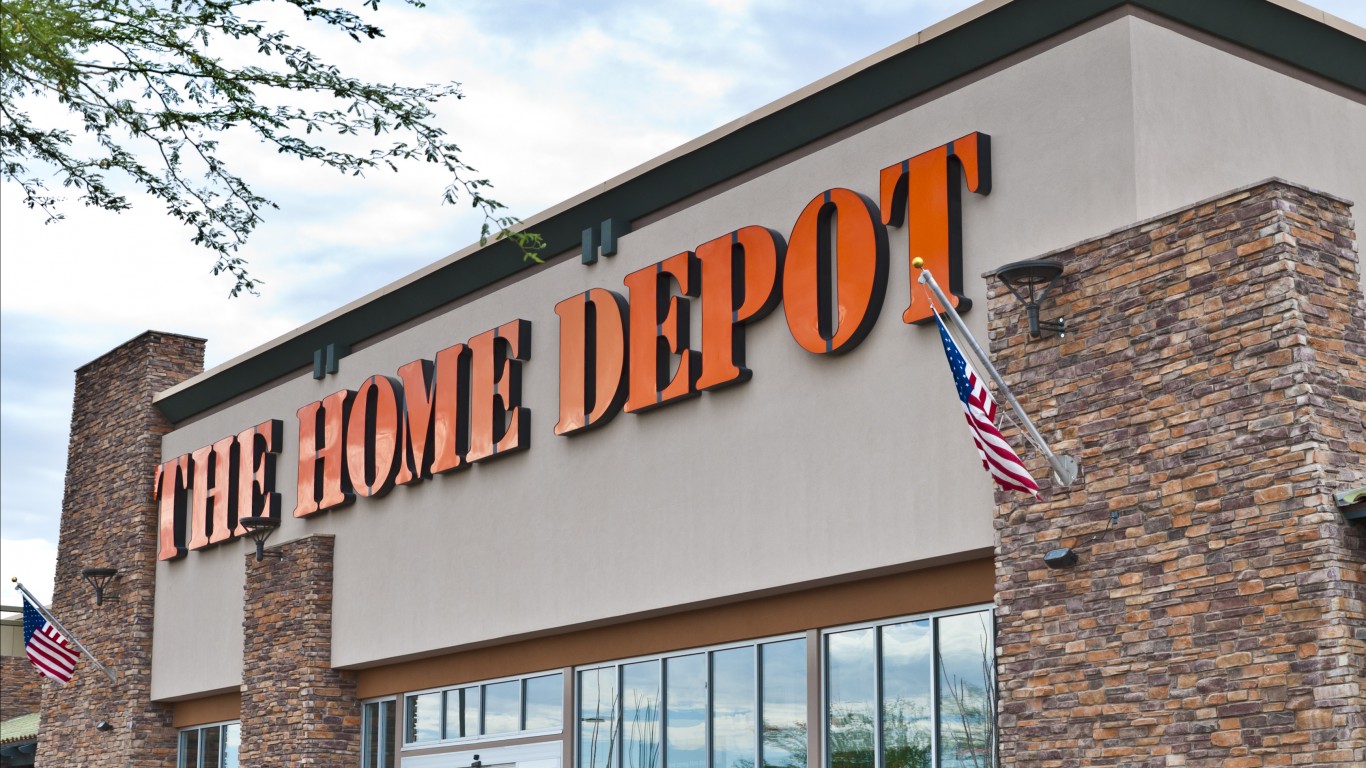
19. The Home Depot
> Pct. of total US retail foot traffic: 0.36%
> Pct. of hardware & services visitors in April: 25.58%
> No. of U.S. stores: 1,981
> Annual revenue: $108.2 billion
The Home Depot reported an $8 billion revenue growth last year. Its net earnings also increased by nearly 30% to $11.1 billion. Home Depot is also outperforming its biggest competitor in foot traffic, as a larger share of consumers in the category visit the hardware store chain than Lowe’s. Some analysts attribute Home Depot’s outperformance to better store locations and its ability to attract more professionals.
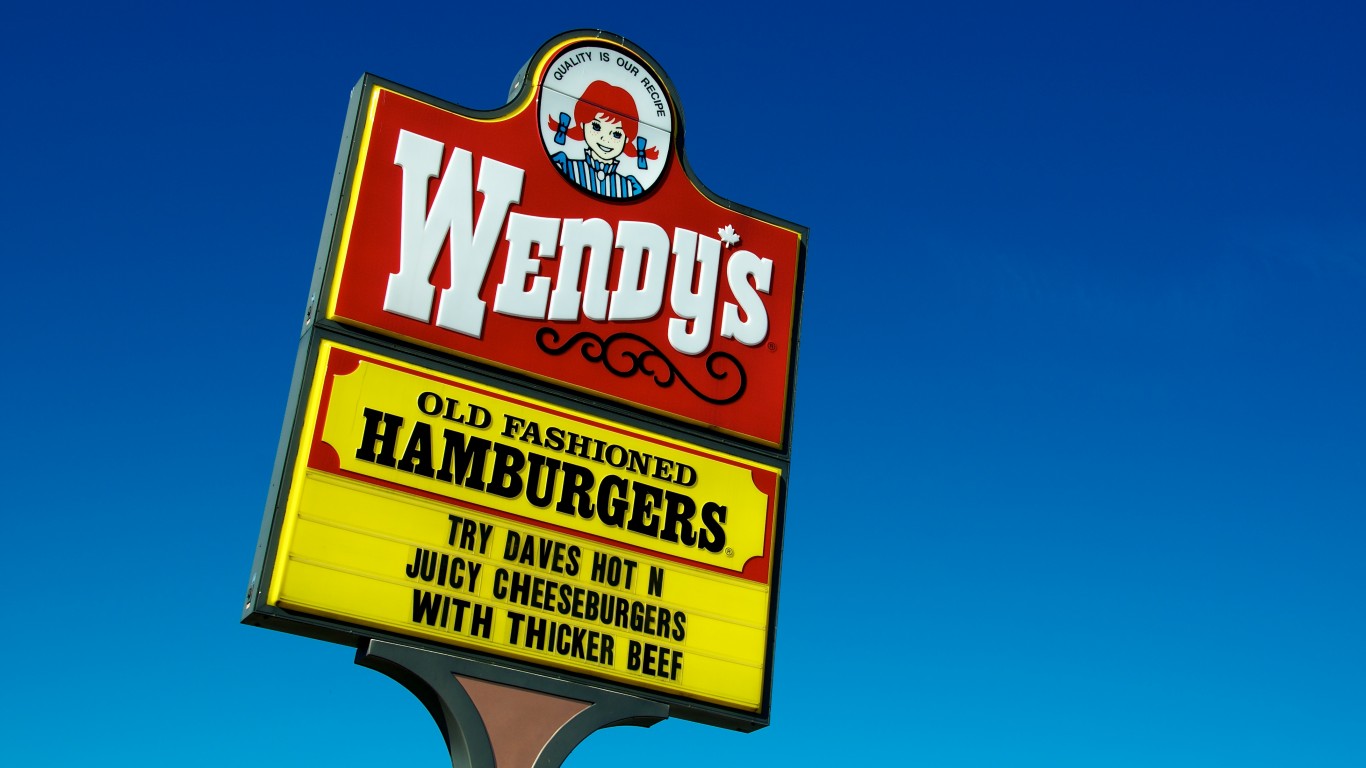
18. Wendy’s
> Pct. of total US retail foot traffic: 0.41%
> Pct. of restaurants visitors in April: 2.24%
> No. of U.S. stores: 5,810
> Annual revenue: $1.6 billion
The Wendy’s Company has 5,810 Wendy’s locations in the United States alone. Only 353 of these restaurants are corporate owned, and 5,457 are franchised. Together, they accounted for 2.24% of American restaurant visits in April 2019. This share is similar to other fast food peers like Taco Bell and Burger King. Wendy’s has about half the amount of foot traffic as Subway and a quarter of that of McDonald’s.
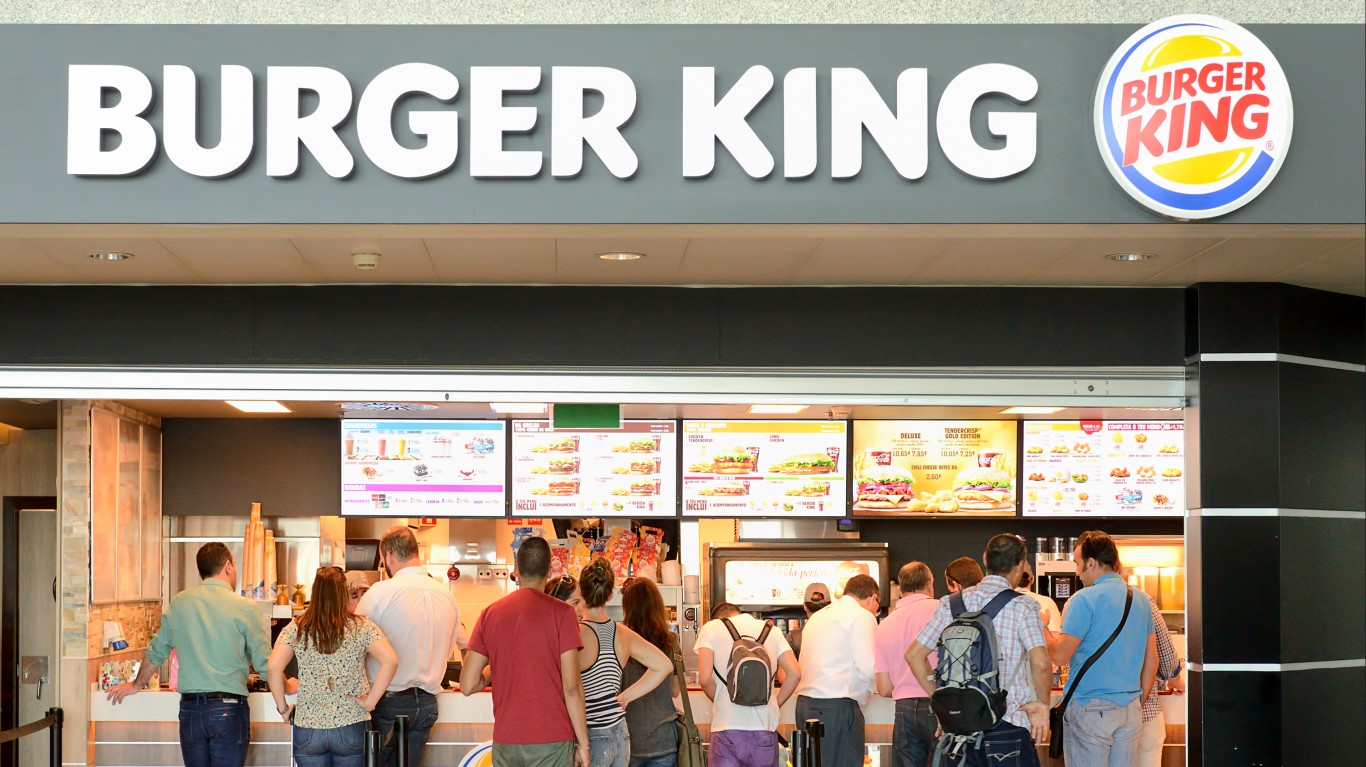
17. Burger King
> Pct. of total US retail foot traffic: 0.43%
> Pct. of restaurants visitors in April: 2.32%
> No. of U.S. stores: 17,796 (Worldwide locations)
> Annual revenue: $1.7 billion
Burger King is an American-founded, Canadian-owned restaurant chain. Parent Restaurant Brands International (RBI) also owns Popeyes, yet Burger King is king within RBI, bringing in more in sales than Popeyes in the United States. Popeyes only captured 0.63% of American restaurant visitors compared to 2.32% for Burger King. RBI said it plans to have 40,000 locations by 2030, more than McDonald’s, with the additional stores likely spread across its three brands.
[in-text-ad-2]
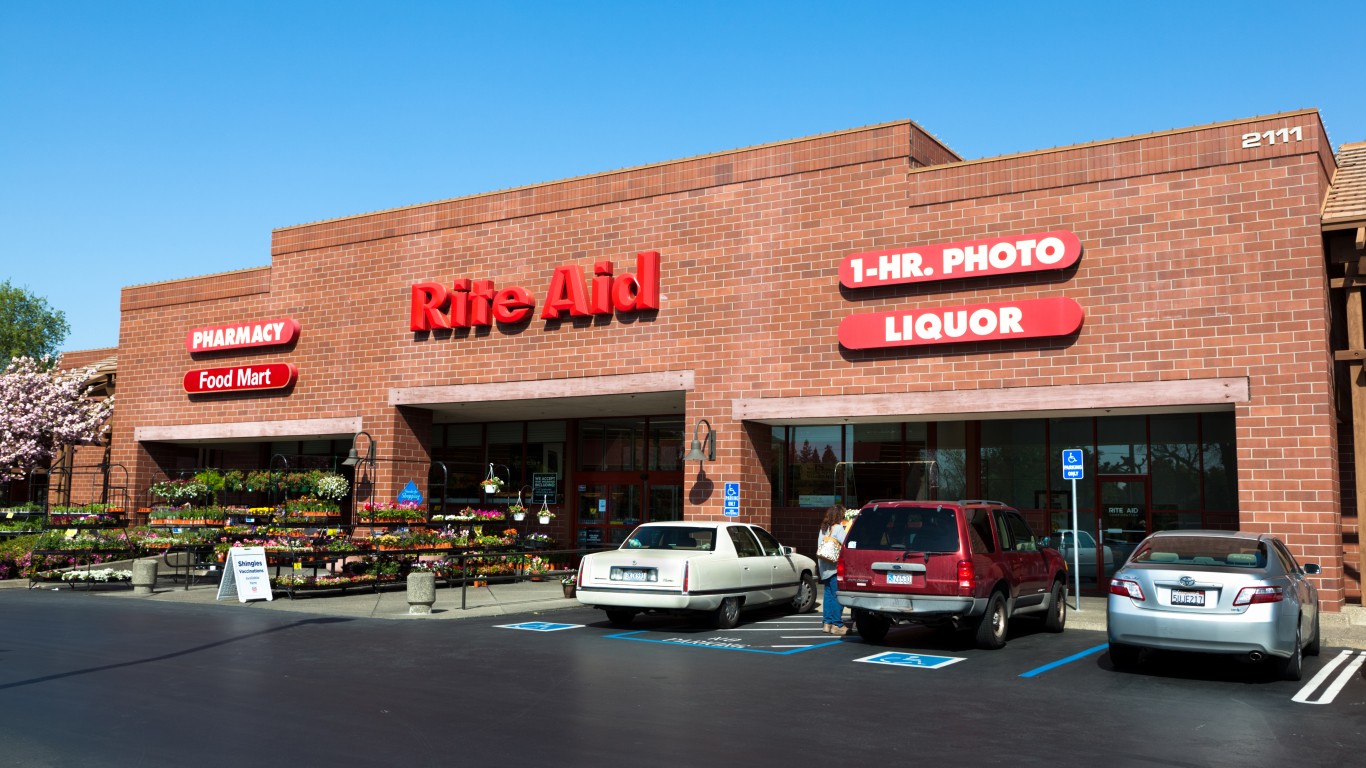
16. Rite Aid
> Pct. of total US retail foot traffic: 0.43%
> Pct. of pharmacies visitors in April: 16.30%
> No. of U.S. stores: 2,469
> Annual revenue: $21.6 billion
About 0.43% of U.S. shoppers visits in April were to Rite Aid. That month, the pharmacy owned about just as much foot traffic as Shell’s convenience stores and Family Dollar — all three stores make up a significant chunk of their sales on food and beverages despite specializing in other areas. Where Rite Aid more specifically competes — drugs and pharmaceuticals — it claimed over 16% of American shoppers.

15. United States Postal Service
> Pct. of total US retail foot traffic: 0.45%
> Pct. of post offices visitors in April: n/a
> No. of U.S. stores: 31,600
> Annual revenue: $69.0 billion
Unsurprisingly, The United States Postal Service (USPS) has more stores than any of its peers amongst the most popular stores in America. The USPS has thousands more locations than the retail store with the second highest number of locations, Subway. If it were a private sector company, the USPS would rank as the 43rd largest company in the United States and the 137th largest in the world, according to the Fortune 500 list. With more than 31,600 retail locations, the USPS has annual revenue of about $69 billion.
[in-text-ad]
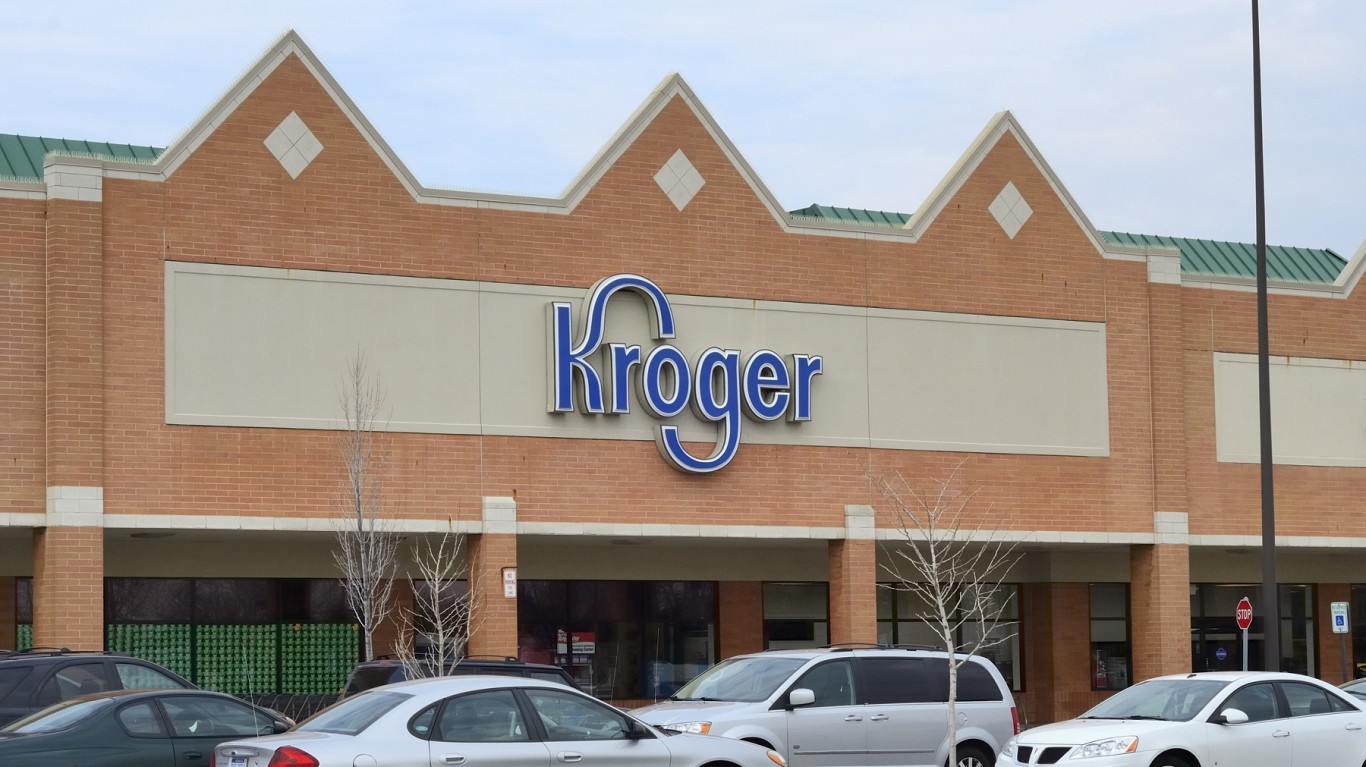
14. Kroger
> Pct. of total US retail foot traffic: 0.46%
> Pct. of supermarkets & groceries visitors in April: 9.19%
> No. of U.S. stores: 2,764
> Annual revenue: $121.2 billion
Kroger, the most popular grocery store in April of 2019, welcomed more than twice the share of visitors as the next most popular grocery chain. This may come as a surprise to coastal readers, as Kroger only captures less than 0.15% of supermarket shoppers on the West Coast and Northeast. In the South and Midwest, however, 60% and 40% of shoppers, respectively choose Kroger for their grocery shopping.

13. Shell
> Pct. of total US retail foot traffic: 0.48%
> Pct. of gas stations & convenience stores visitors in April: 9.45%
> No. of U.S. stores: 14,000
> Annual revenue: $388.4 billion
Of the different convenience store gas stations, Shell’s were the second most popular in the United States. Shell’s stores were visited by 0.5% of all American shoppers in April, and by 9.45% of gas station and convenience store shoppers. Shell’s revenues ($388.38 billion in 2018), were predominantly from businesses in its downstream operations, including oil products and chemicals.

12. Taco Bell
> Pct. of total US retail foot traffic: 0.50%
> Pct. of restaurants visitors in April: 2.73%
> No. of U.S. stores: 6,446
> Annual revenue: $10.8 billion
Taco Bell is a division of Yum! Brands and has 6,446 stores in the United States. It is the third most popular restaurant in the country, though it also ranks behind Dunkin Donuts and Starbucks, which serve food as well. Taco Bell reported $10.79 billion in revenue in 2018. Taco Bell ranks behind fellow Yum! Brands restaurants Pizza Hut and Kentucky Fried Chicken in terms of revenue, but has captured a much higher share of retail foot traffic in the United States.
[in-text-ad-2]
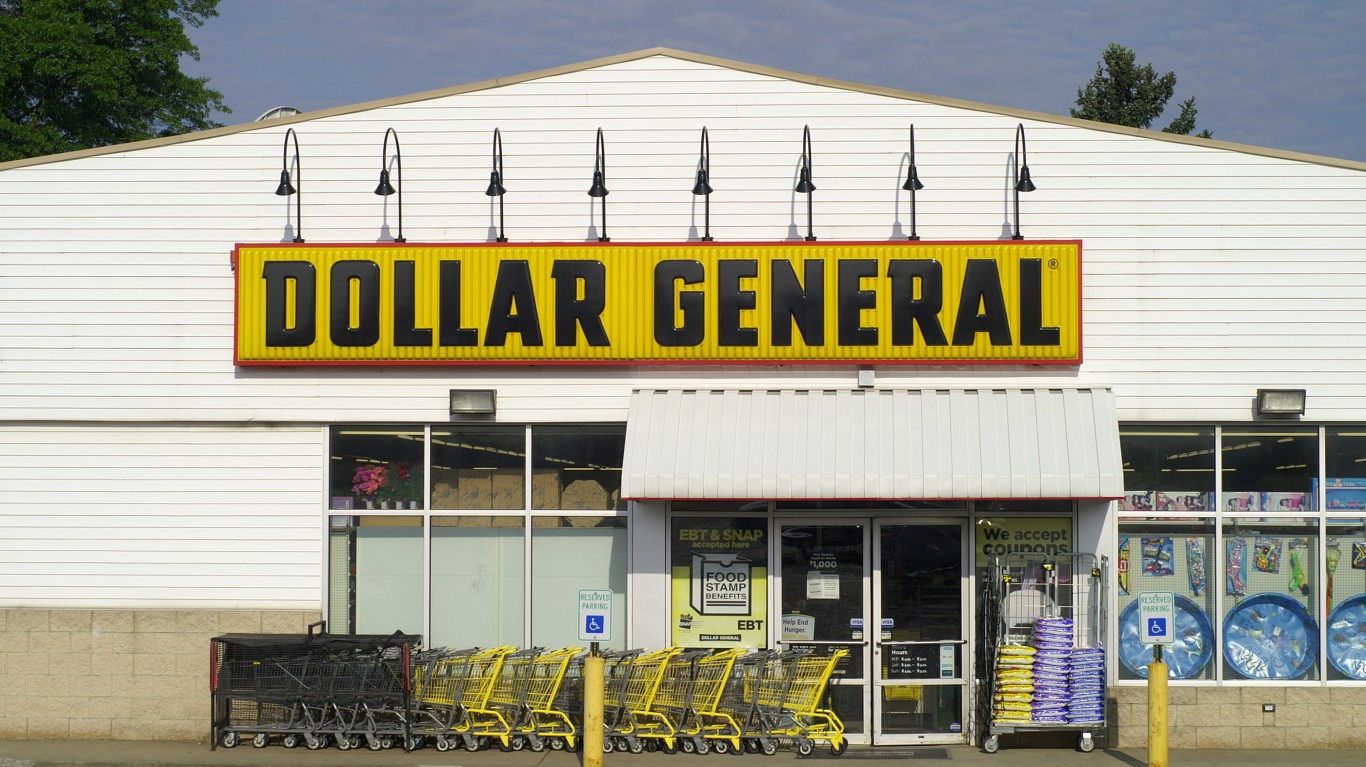
11. Dollar General
> Pct. of total US retail foot traffic: 0.51%
> Pct. of discount stores, warehouses & wholesale stores visitors in April: 19.98%
> No. of U.S. stores: 15,472
> Annual revenue: $25.6 billion
Not including restaurants or the post office, Dollar General has among the most stores of retail stores on this list. Consumables like paper products, cleaning supplies, perishable foods, and health and beauty products are Dollar General’s largest driver of business, accounting for over three quarters of total sales.
Dollar General brought in nearly 20% of discount store foot traffic in April. The company also reported a 9.2% increase in revenue in fiscal 2019.
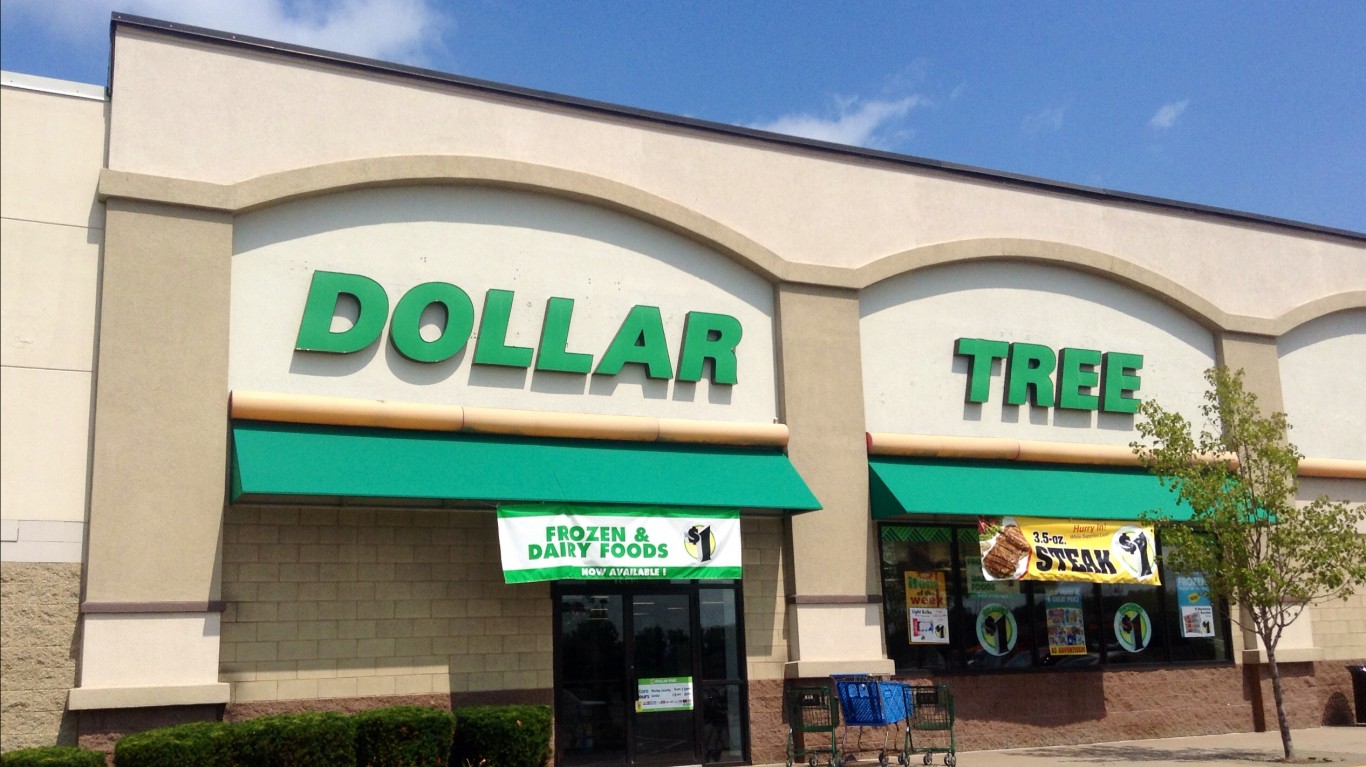
10. Dollar Tree
> Pct. of total US retail foot traffic: 0.55%
> Pct. of discount stores, warehouses & wholesale stores visitors in April: 22.33%
> No. of U.S. stores: 6,776
> Annual revenue: $22.8 billion
Dollar Tree is the most popular discount store in the United States by foot traffic. Dollar Tree-branded discount store locations accounted for 22.33% of all discount store visitors in the United States in April.
In July 2015, Dollar Tree acquired rival discount brand Family Dollar and its more than 8,200 store locations. Family Dollar brand stores are slightly less popular than Dollar Tree, with 0.29% of total foot traffic. For now, the parent company announced it is committed to continuing to expand both brands, rather than rebrand as a single entity.
[in-text-ad]

9. Dunkin’ Donuts
> Pct. of total US retail foot traffic: 0.56%
> Pct. of bagel & doughnut store visitors in April: 80.62%
> No. of U.S. stores: 9,419
> Annual revenue: $1.3 billion
Dunkin’ Donuts dominates the bagel and doughnut store category by capturing over 80% of Americans who entered those types of shops in April. Dunkin’ Brands, the parent company of Dunkin Donuts, also owns Baskin-Robbins, an ice cream parlor chain. Baskin Robbins is far less popular than Dunkin Donuts, though it captures an estimated 18.64% of all ice cream shop foot traffic.

8. Target
> Pct. of total US retail foot traffic: 0.62%
> Pct. of department stores visitors in April: 14.74%
> No. of U.S. stores: 1,844
> Annual revenue: $75.4 billion
Target, America’s eighth most popular store in April, reported a 36% increase in revenue and at 0.8% increase in profits in 2019 from the year before. With China tariffs beginning to take their toll on department stores that heavily source from that region, it remains to be seen if this growth will continue. Margins in the space have been under pressure for some time due to the negative variables of both tariffs and digital platforms.
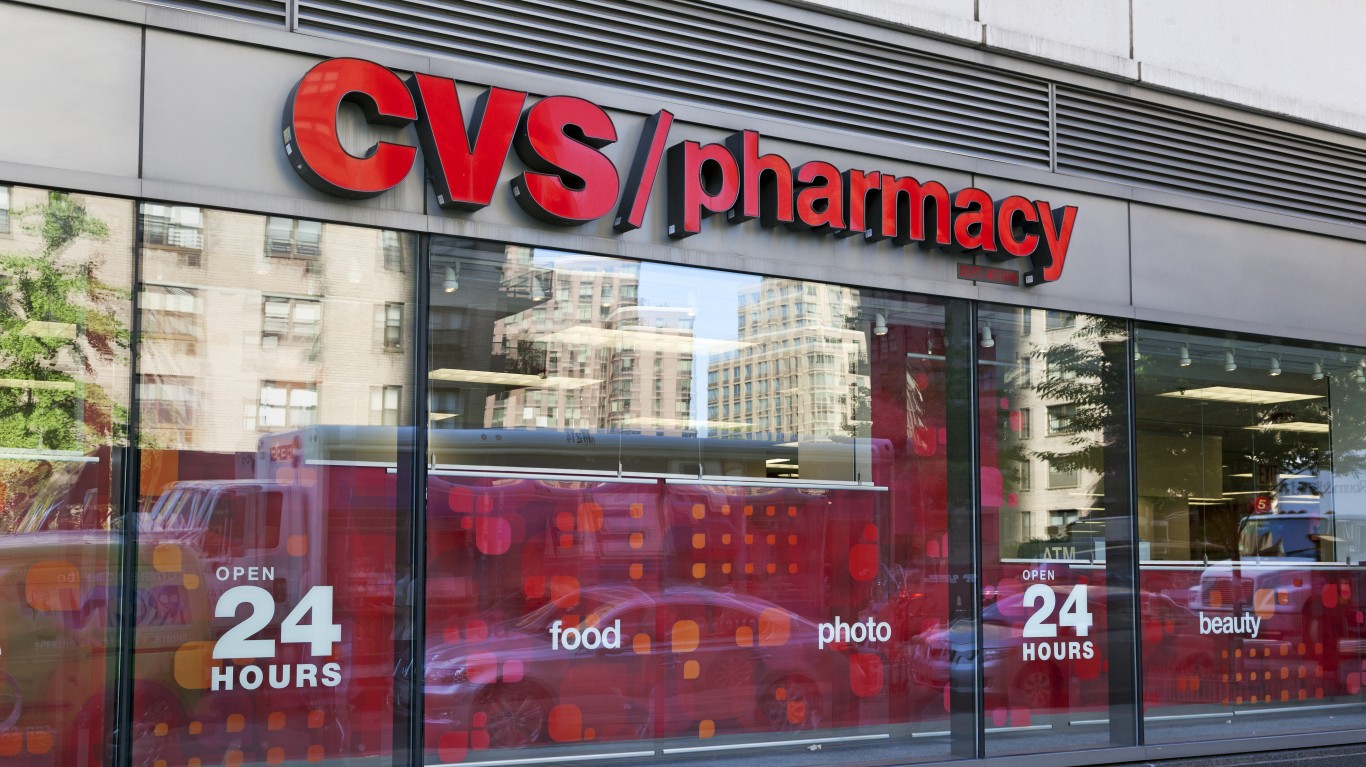
7. CVS
> Pct. of total US retail foot traffic: 0.70%
> Pct. of pharmacies visitors in April: 26.42%
> No. of U.S. stores: 9,900 (Locations in U.S. and Brazil)
> Annual revenue: $194.6 billion
CVS stores were the second most visited pharmacy and health care stores in the U.S. market in April of 2019. The Woonsocket, Rhode Island-based retailer and pharmacy chain reported $194.58 billion in revenue in 2019. Recent political changes have reshaped the health care market, and pharmacies like CVS must adapt. The company was on the hook for a $157 million Health Insurer Fee, as mandated by the Affordable Care Act.
[in-text-ad-2]
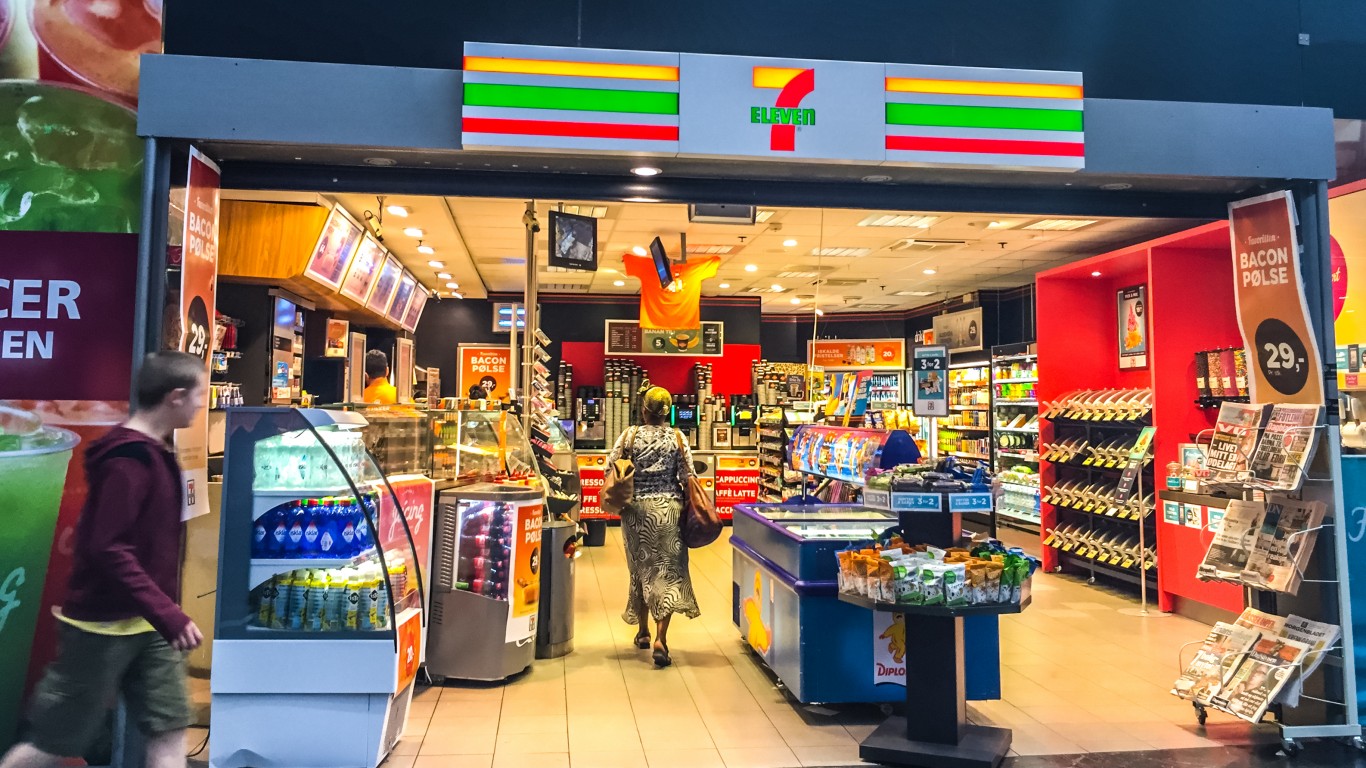
6. 7-Eleven
> Pct. of total US retail foot traffic: 0.70%
> Pct. of gas stations & convenience stores visitors in April: 13.78%
> No. of U.S. stores: 9,573
> Annual revenue: $109.9 billion
7-Eleven captured the most convenience store shoppers this April at 13.78% of all shoppers who visited convenience stores. 7-Eleven’s primary convenience store business is thriving, with revenues growing by 29.8% in the first quarter of this year. In addition, the company recently opened 903 U.S. stores for a total of 9,573 U.S. locations.
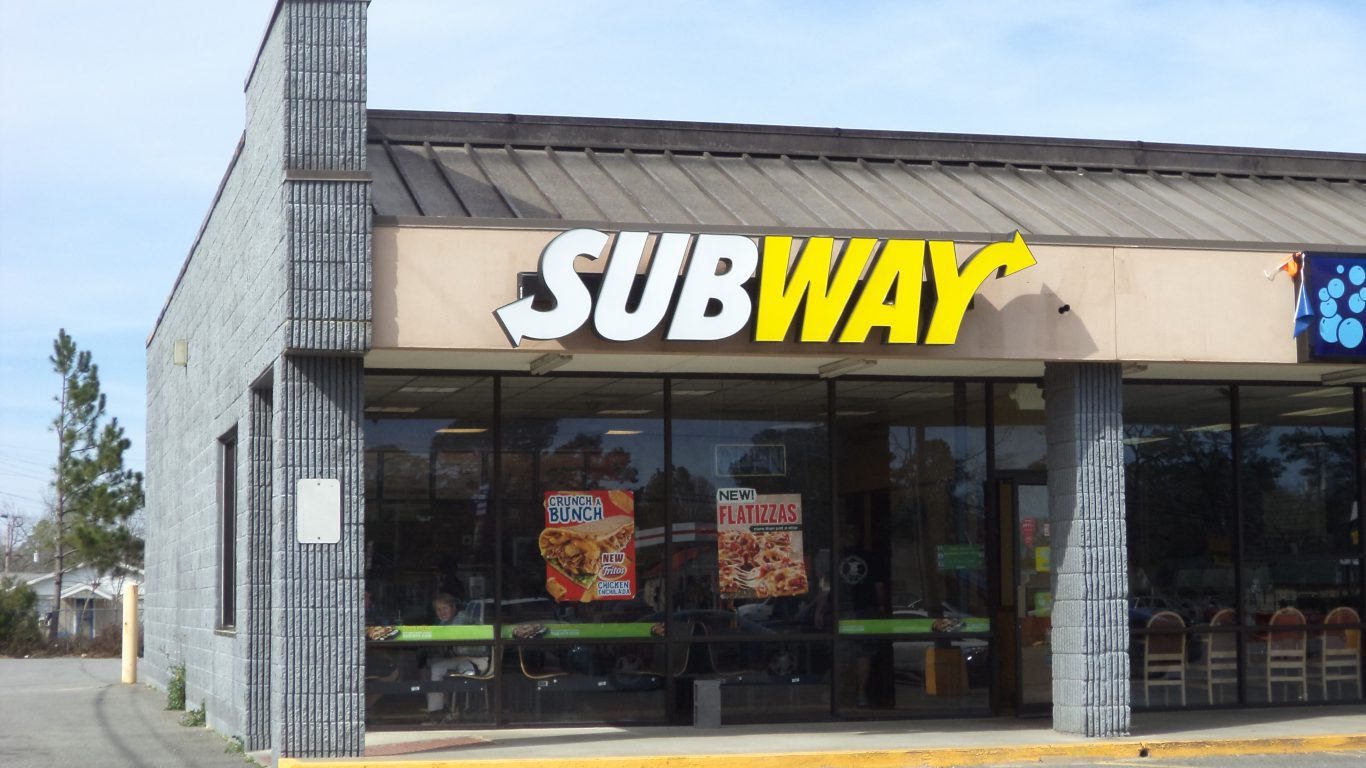
5. Subway
> Pct. of total US retail foot traffic: 0.82%
> Pct. of restaurant visitors in April: 4.44%
> No. of U.S. stores: 24,304
> Annual revenue: N/A
With 24,304 stores in the United States, and counting, Subway has more locations than any other restaurant chain. It is one of the largest privately owned food companies in the nation and the most popular quick-service restaurant for submarine sandwiches (subs) and salads. Subway’s rank as the second most popular restaurant franchise in America has not been challenged from last year, but its market share has declined significantly due to an increase in competition from smaller players. After peaking at more than 27,000 locations in 2015, the chain has since closed more stores than it opened.
[in-text-ad]

4. Walgreens
> Pct. of total US retail foot traffic: 0.92%
> Pct. of pharmacies visitors in April: 34.63%
> No. of U.S. stores: 9,451
> Annual revenue: $30.8 billion
The most popular pharmacy in America so far this year is Walgreens. The company reported a 11.27% revenue growth in 2018 from 2017. In addition to Walgreens popular stores — which include both Walgreens and Duane Reade stores — the company also owns a handful of product lines that sell globally, including No7, Soap & Glory, Liz Earle, Sleek MakeUP, and Botanics. Walgreens not only claimed more than a third of American pharmacy visitors in March, but it also filled over 1 billion prescriptions during fiscal year 2018.
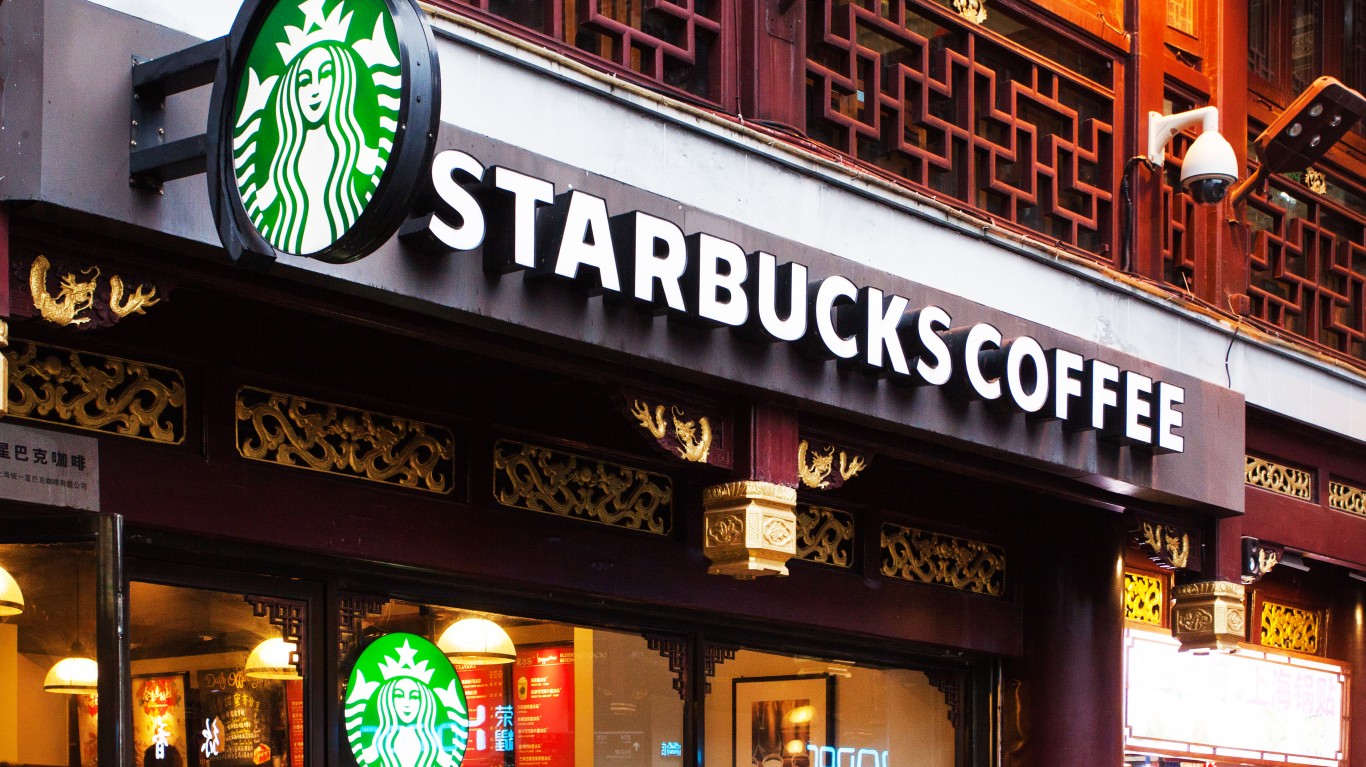
3. Starbucks
> Pct. of total US retail foot traffic: 1.13%
> Pct. of cafe, coffee house, & tea house visitors in April: 77.94%
> No. of U.S. stores: 14,606
> Annual revenue: $24.7 billion
Nearly 78% of Americans who purchased their lattes on-the-go in March did it at Starbucks. The number of Starbucks stores — both company owned and franchises — increased significantly between fiscal year 2017 and 2018. The major coffee chain has reported revenue growth of over $1 billion year-over-year since at least 2014. Starbucks reported a 10% increase in net revenue in 2018. Starbucks has more stores than any other coffee shop in the nation.

2. McDonald’s
> Pct. of total US retail foot traffic: 1.57%
> Pct. of restaurant visitors in April: 8.51%
> No. of U.S. stores: 13,914
> Annual revenue: $21.0 billion
It is no surprise to American consumers that McDonald’s is the most visited restaurant — it has been consistently for years. Consistency is synonymous with McDonald’s, from years of growing guest counts to 15 consecutive quarters of positive global comparable sales growth. The company was able to return $8.5 billion to shareholders through share repurchases and dividends in 2018. Looking to the future, McDonald’s aims to continue its growth trend among American consumers by focusing on additional coffee shop products, like donut sticks and new McCafé coffee offerings.
[in-text-ad-2]
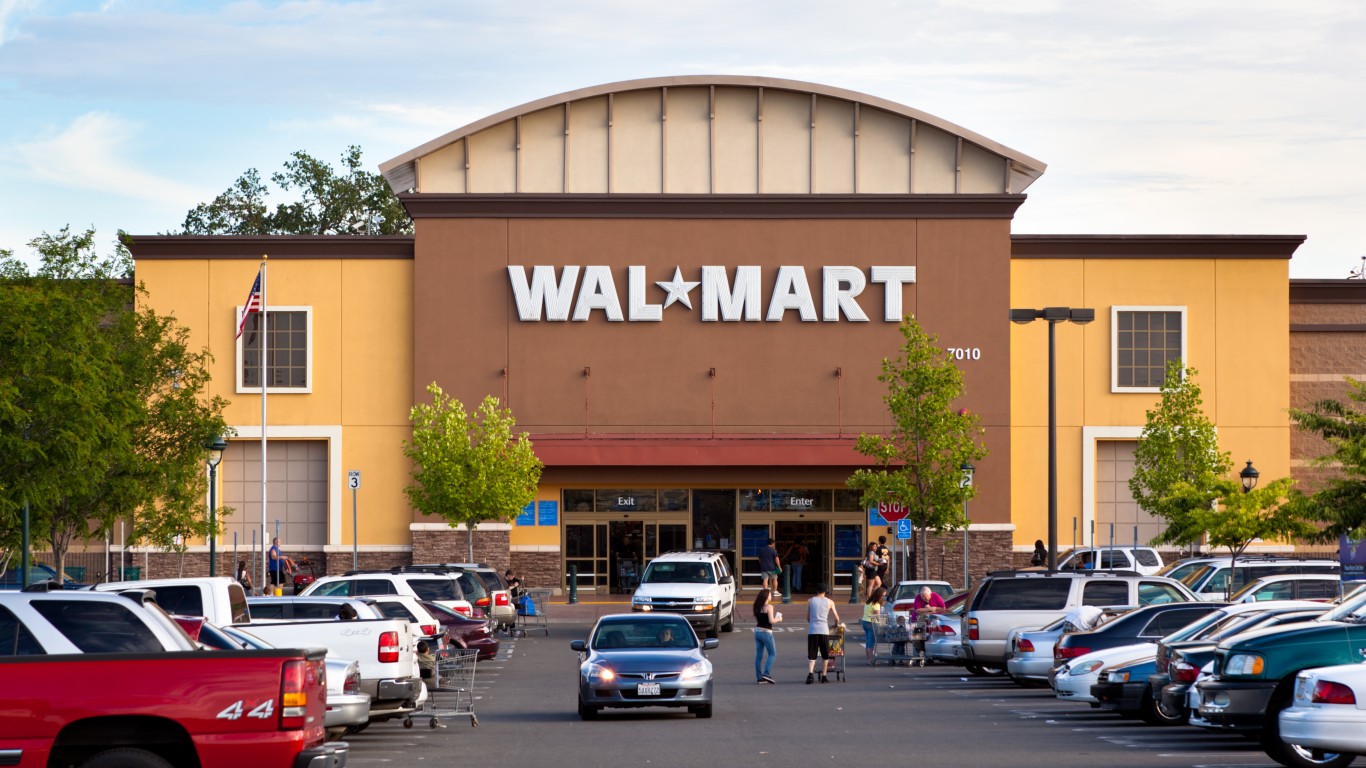
1. Walmart
> Pct. of total US retail foot traffic: 2.00%
> Pct. of department store visitors in April: 47.23%
> No. of U.S. stores: 5,368
> Annual revenue: $514.4 billion
Capturing nearly half of all department store visitors in the United States, Walmart reported $514.4 billion in net sales in fiscal 2019. Though many retailers are struggling to compete with Amazon, Walmart reported the best first quarter overall sales in nearly a decade, demonstrating its brick-and-mortar operations are running strong. Walmart’s ad spending topped $3 billion in 2018. There are more than 5,300 Walmart locations in the United States, including Supercenters, Neighborhood Markets, and Sam’s Club stores.
Is Your Money Earning the Best Possible Rate? (Sponsor)
Let’s face it: If your money is just sitting in a checking account, you’re losing value every single day. With most checking accounts offering little to no interest, the cash you worked so hard to save is gradually being eroded by inflation.
However, by moving that money into a high-yield savings account, you can put your cash to work, growing steadily with little to no effort on your part. In just a few clicks, you can set up a high-yield savings account and start earning interest immediately.
There are plenty of reputable banks and online platforms that offer competitive rates, and many of them come with zero fees and no minimum balance requirements. Click here to see if you’re earning the best possible rate on your money!
Thank you for reading! Have some feedback for us?
Contact the 24/7 Wall St. editorial team.
 24/7 Wall St.
24/7 Wall St.


